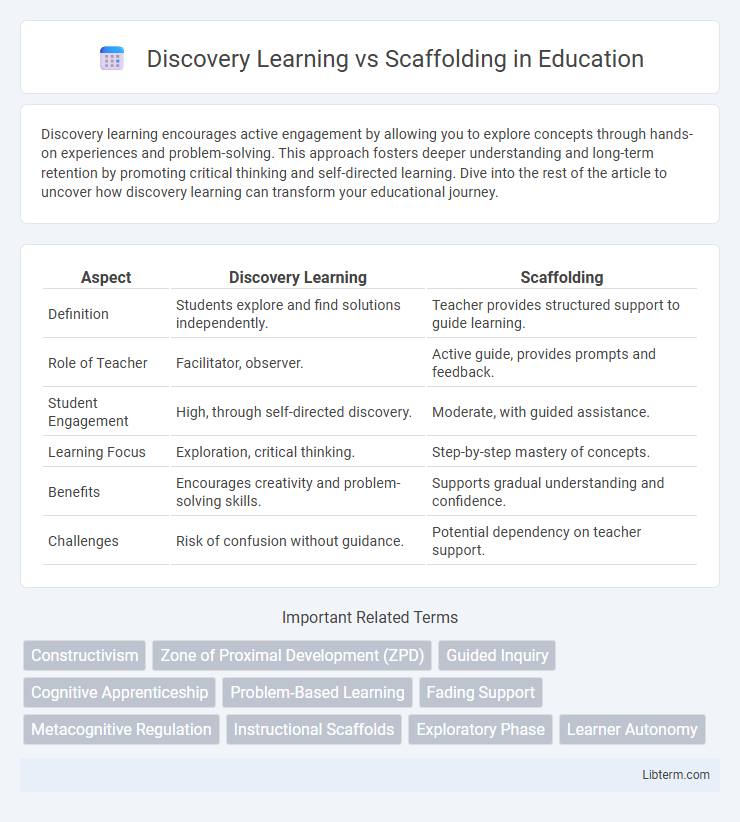Discovery learning encourages active engagement by allowing you to explore concepts through hands-on experiences and problem-solving. This approach fosters deeper understanding and long-term retention by promoting critical thinking and self-directed learning. Dive into the rest of the article to uncover how discovery learning can transform your educational journey.
Table of Comparison
| Aspect | Discovery Learning | Scaffolding |
|---|---|---|
| Definition | Students explore and find solutions independently. | Teacher provides structured support to guide learning. |
| Role of Teacher | Facilitator, observer. | Active guide, provides prompts and feedback. |
| Student Engagement | High, through self-directed discovery. | Moderate, with guided assistance. |
| Learning Focus | Exploration, critical thinking. | Step-by-step mastery of concepts. |
| Benefits | Encourages creativity and problem-solving skills. | Supports gradual understanding and confidence. |
| Challenges | Risk of confusion without guidance. | Potential dependency on teacher support. |
Introduction to Discovery Learning and Scaffolding
Discovery Learning emphasizes active student engagement through exploration and problem-solving to construct knowledge independently. Scaffolding provides structured support and guidance tailored to the learner's current abilities, gradually removed as competence increases. These approaches complement each other by balancing autonomous learning with targeted instructional assistance.
Historical Background and Theoretical Foundations
Discovery learning traces back to the early 20th century cognitive theories of Jerome Bruner, emphasizing active student engagement and self-guided exploration. Scaffolding originates from Lev Vygotsky's social development theory, particularly the Zone of Proximal Development (ZPD), highlighting the role of guided assistance in learning. Both approaches are rooted in constructivist principles but differ as discovery learning promotes autonomous problem-solving, while scaffolding relies on structured support to gradually transfer responsibility to the learner.
Key Principles of Discovery Learning
Discovery learning emphasizes active engagement where learners explore and investigate concepts independently, fostering deeper understanding through hands-on experience. Key principles include cognitive conflict to challenge prior knowledge, intrinsic motivation driven by curiosity, and the use of problem-solving tasks that encourage learners to construct their own understanding. This approach contrasts with scaffolding, which provides structured support to gradually build knowledge and skills.
Core Elements of Scaffolding
Core elements of scaffolding include guided participation, where expert support adjusts to the learner's evolving skill level, and the use of prompts or cues to facilitate problem-solving and understanding. Scaffolding emphasizes interaction and feedback, ensuring learners can achieve tasks beyond their independent capabilities by gradually removing assistance as competence increases. This contrasts with discovery learning, which relies more on learners independently exploring and constructing knowledge without immediate structured support.
Comparing Instructional Approaches
Discovery learning encourages students to explore concepts independently through trial and error, fostering critical thinking and problem-solving skills. Scaffolding provides structured support by gradually introducing new information and guiding learners until they achieve mastery, promoting confidence and understanding. Comparing these instructional approaches reveals that discovery learning emphasizes autonomy and exploration, while scaffolding ensures comprehension through targeted assistance.
Impact on Student Engagement and Motivation
Discovery learning fosters student engagement by encouraging exploration and problem-solving, which enhances intrinsic motivation and curiosity. Scaffolding supports motivation by providing tailored guidance that helps students build confidence and achieve success in challenging tasks. Both methods significantly impact student engagement, with discovery learning promoting autonomy and scaffolding ensuring sustained progress through structured support.
Cognitive Outcomes: Knowledge Retention and Transfer
Discovery learning promotes deeper cognitive processing by encouraging learners to explore and construct knowledge independently, leading to improved long-term knowledge retention and flexible application across varied contexts. Scaffolding provides structured support that gradually fades, enabling learners to build foundational understanding and effectively transfer skills to new problems by bridging cognitive gaps. Research indicates that combining discovery learning with targeted scaffolding enhances both knowledge retention and transfer by balancing active engagement with strategic guidance.
Practical Applications in the Classroom
Discovery learning encourages students to explore concepts independently, fostering critical thinking and problem-solving skills, which is particularly effective in inquiry-based science lessons. Scaffolding provides structured support through guided questions, prompts, and modeling, enabling students to build on prior knowledge and achieve learning goals more efficiently in subjects like mathematics and language arts. Combining both approaches allows teachers to tailor instruction, promoting autonomy while ensuring students receive the necessary assistance to master complex tasks.
Challenges and Limitations of Each Method
Discovery learning often presents challenges such as student frustration due to insufficient guidance and the potential for misconceptions when learners explore concepts independently without structured support. Scaffolding requires precise calibration of assistance, as excessive help can inhibit critical thinking while too little can leave students confused and disengaged. Both methods demand significant teacher expertise and time investment to effectively balance autonomy and support, posing practical limitations in diverse classroom settings.
Choosing the Right Approach for Diverse Learners
Choosing the right approach for diverse learners involves assessing individual needs and learning styles to determine whether discovery learning or scaffolding will be more effective. Discovery learning promotes active exploration and critical thinking, ideal for learners who thrive on autonomy and self-directed problem-solving. Scaffolding provides structured support that gradually decreases as competence grows, benefiting learners who require guided assistance to build foundational skills and confidence.
Discovery Learning Infographic

 libterm.com
libterm.com